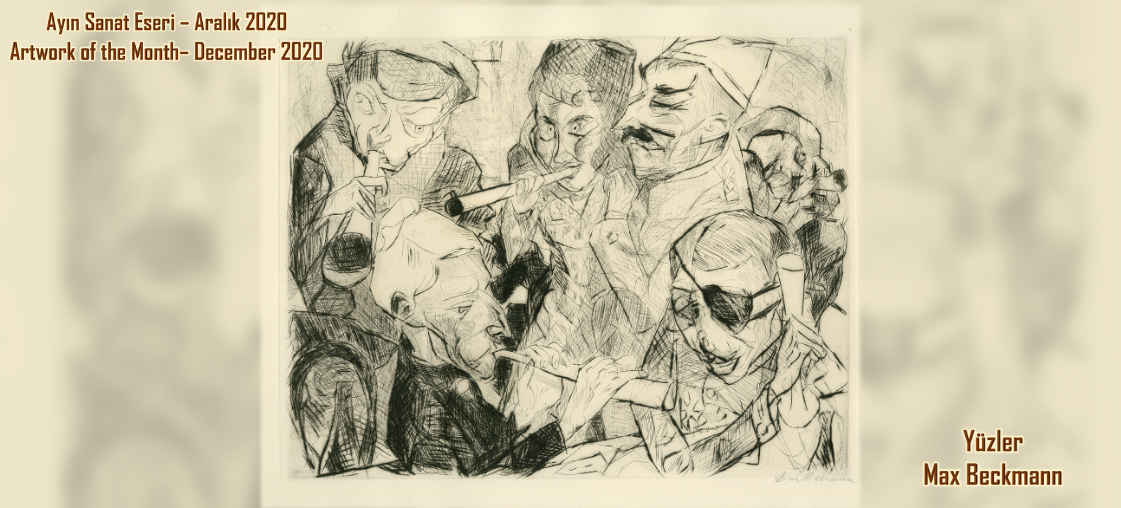Bu ay #GüvenlikPortalı’nın kapak fotoğrafı, Alman sanatçı Max Beckmann’ın 1917 tarihli eseri (1’inci Dünya Savaşı’ndan) Yüzler (Gesichter).
Yüzler, yaşamın değişik anlarını ele alan, 1915-1918 arası yapılmış ve 19 baskıdan oluşan bir seridir. Esasen biri savaşı, diğeriyse şehir yaşamını simgeleyen sahnelerden oluşan iki serinin birleşimidir. Sanatçı bu seride abartılmış ve çarpıtılmış yüzler ve mekânlar kullanır.
Burada seçilen baskı, “Prosit Neujahr 1917” (Happy New Year 1917) isimli eserdir. Kutlama sahnesi gibi görünse de aslında bir savaş anısını sembolize eder. Eser, Beckmann’ın savaşta yaşadığı travmayı yansıtır. 1914 yılında gönüllü olarak askere yazılan Beckman, hemen ön cepheye gönderilir ve Belçika’da tıbbi birliklerde yer alır. Burada geçirdiği bir sinir krizinin ardından 1915 yılında terhis edilir. Bu tarihten sonra kendisine ve sanata bakışı değişir; çarpıtılmış ve abartılmış figürlere dayalı bir ifade biçimini tercih etmeye başlar. Bu desenlerin önemi, sanatsal ifadelerinin yanında tarihsel birer kayıt olmalarıdır; savaşın insan bedeni ve ruhunda bıraktığı etkiyi gözler önüne sererler.
Savaşta memurlar için kullanılan özel bir revirde geçtiği tahmin edilen sahnede, altı biçimsiz insanın düdük çaldığı görülür. Normal olmama durumunu yüzlerdeki ifadeler ve farklı yüzlerin arasındaki ilişkisizlik halinden anlamak mümkündür. Sağ alttaki figürün savaşta ağır yaralar almış olan ressamın bir arkadaşı olduğu düşünülmektedir.
Max Beckmann, yarattığı eserle savaşın bireyler üzerindeki travmatik etkisini görselleştirmiştir. Yüz ifadelerindeki çarpıcılığın ötesinde figürlerin duruş açıları, çizginin gücü ve üç boyutluluğu, desenin zenginliği göz alıcıdır.
https://i1.wp.com/circulatingnow.nlm.nih.gov/wp-content/uploads/2018/04/hny.jpg?ssl=1
***
This month’s artwork of the #SecurityPortal is German artist Max Beckman’s 1917 painting Faces (from WWI).
Faces is a series of 19 editions, created between 1915-1918, that depicts different moments of life. Essentially, this artwork is a combination of two series of scenes, one symbolizing war and the other city life. The artist uses exaggerated and distorted spaces, as well as faces, in this series.
The edition chosen here is “Prosit Neujahr 1917” (Happy New Year 1917). Even though it looks like a celebration scene at the first glance, it actually symbolizes a memory of war. The artwork depicts Beckmann’s trauma during the war. Having been voluntarily enlisted in the military in 1914, Beckmann was immediately sent to the front and took part in several medical units in Belgium. After going into hysterics, Beckmann was discharged in 1915. Following this incident, the artist’s view of himself and art changes, he begins to prefer a form of expression based on distorted and exaggerated figures. Since they do not only display artistic expressions but they are also historical records, these patterns used in the artwork are quite significant. They reveal the effect of war on the human body and soul.
Six amorphous people are blowing their whistles in the scene, which is assumed to take place in a special infirmary used for civil servants during the war. The abnormality is obvious both in the expressions on the faces and in the state of unrelatedness between different faces. The figure on the bottom right is considered to be a colleague of Beckmann who suffered severe injuries in the war.
Max Beckmann visualizes the traumatic effect of war on individuals in his artwork. In addition to the impressive facial expressions, the stance of the figures, the power and three-dimensionality of the drawing, and the richness of the pattern is eye-catching.
https://i1.wp.com/circulatingnow.nlm.nih.gov/wp-content/uploads/2018/04/hny.jpg?ssl=1

